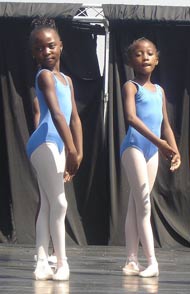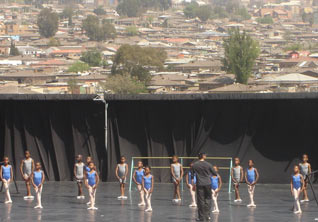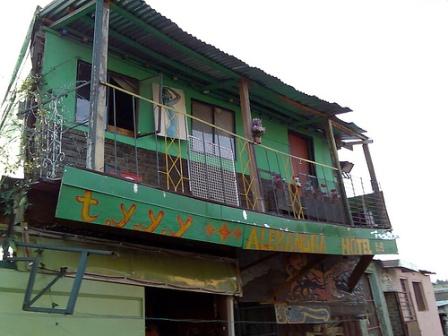ERICA DREIJER
HOPE is buried below smoke and fog. Dark narrow streets wind around stockpiled shacks.
For many living in Alexandra, one day spills into the next, with no light at the end of their existence. Their neighbours are unemployment, hunger, personal suffering and crime.
Still, for others all hope is not lost in “the dark city”. Some are trying to forge forward, despite their circumstances.
Often relief, in communities like Alex, does not come from large, elaborate initiatives and funding; but rather from small initiatives that uplift the lives of individuals.
As William Easterly, a professor in economics at New York University and formerly a senior research economist at the World Bank noted in his book – The White Man’s Burden: “Sixty years of countless reform schemes to aid agencies and dozens of different plans, and $2.3 trillion later, the aid industry is still failing to reach the beautiful goal [of making poverty history]. The evidence points to an unpopular conclusion: Big Plans will always fail to reach the beautiful goal.”
Easterly believes solutions for issues like poverty can be found within “Searchers” – people who believe that only “insiders have enough knowledge to find solutions, and that most solutions must be homegrown.”
Home grown local solutions include initiatives like the Ballet Theatre Afrikan (BTA) Company and imaginationlab. These give hope and change the course of lives. Young hopefuls joining these programmes are taught skills that will allow them to become self-sustaining and provide a better life for their offspring.
“I have so many kids coming out of Alex. I have changed their lives. I have changed their family. By becoming involved in ballet, you have changed an entire family through one child. You are changing the whole fabric of that society. Change comes about by changing one person’s life, not the masses,” explained Martin Schönberg, retired ballet dancer and artistic director of BTA.
In 2000 at the United Nations Millennium Summit, the world’s leaders set out to improve living conditions of those living on the continent by 2015. They identified eight key areas – called the Millennium Development Goals (MDGs) – with the common goal of creating human dignity and a world free of poverty and injustice.
Post 1994, South Africa has been marked by large economic growth. And many initiatives have contributed to improving the livelihood of those that had little access to basic necessities in the apartheid years.
But life in Alexandra has remained more or less unchanged.
Dogged by crime, violence, overcrowding, lack of infrastructure and high unemployment from the 1930s, Alex today still struggles with the same issues.
Gauteng’s oldest township, continues to be one of the poorest in the region, even though it is only 3kms away from Sandton, one of Africa’s wealthiest suburbs.
An influx of youth, in search of employment in Johannesburg, contributes to exacerbate living condition for those living here.
Unofficial estimates figures report unemployment to be in the region of 60%, more widespread among women (40%) than men (19%) and the average household income is about R1 029 per month.
Old Alex is mainly characterised by informal dwellings, shacks and hostels and the 7.6 square kilometres over which Alex stretches houses 350 000 people or 45 000 per square kilometre, against the urban norm of 2 500 per square kilometre.
As most shacks are not connected to the electricity grid, inhabitants resort to illegally tapping the main power lines. Only about 65% of households have access to piped water. And less than 20% of households have access to private toilet facilities.
It is against this backdrop, that the value of the work that the BTA and imaginationlab do injects some hope.
Art and culture play an important role in creating sustainable human development. And with the South African Department of Education including it into the school curriculum its importance for developing a nation becomes evident.
Schönberg started BTA in Alexandra 17 years ago, after a dinner guest said “it’s a pity about the blacks, they got wonderful rhythm, but unfortunately they really can’t do classical ballet.”
The company has received praise both locally and internationally for producing black dancers of world class standard and continues to look for talent from previously disadvantaged sectors of society.
“It was something I needed to do, and it was something that the children yearned for. They loved it,” Schönberg realised after starting BTA in Alex.
Schönberg believes that those children training under his guidance are not just getting another “art class”, but a whole new way of life. “Understanding the whole package of what makes a ballet dancer,” is important, he explained. Aspects taught include music, history and even the anatomy of what makes each dancer unique.
Dancers receive classical training as well as training in contemporary dance, jazz, Spanish and Afrofusion, which consists of a mix of traditional African dance and other styles.

Picture courtesy www.joburg.org.za
Thirty children are selected to train with BTA in Alex each year. Classes are free and leotards and shoes are donated by the school. Children are also given a meal before each class to improve their concentration.
It is hard work that will one day pay off as “many have gone on to dance internationally,” he said. Classes take place, four afternoons a week. Each is two hours long.
The objective is to develop professional dancers, choreographers and dance teachers from within under-resourced communities in South Africa that will be able to be employed locally or internationally.
“The need for this academy, resulting in the production of dancers of an international standard that can go out into the marketplace and earn their living from dance, has been identified by the community and a solution has been requested repeatedly over many years,” said Paula Kelly, the previous administrative director of BTA.
“The academy will, in addition, produce a number of qualified teachers of dance from the community,” she said.
Another initiative operating out of Alex is the imaginationlab, a facility that gives school leavers the opportunity to discover their creative strengths and passion when considering careers in creative fields like design, fashion, copy writing and photography.
The imaginationlab was borne from a dream that Gordon Cook and Andy Snyman had to help youth discover themselves through their creativity and to impart valuable life skills.
McDonald Musimuko, a student at the lab in Alex, said: “For those who finish school and are brain stuck, that do not know what to do, it [the imaginationlab] gives you a good idea of what you want to do.”
As part of his dream, Cook wanted to put these young adults “into a sandpit and give them lots of toys to play with to stimulate their creativity” by exposing them to different creative stimuli that would help them find a niche through which they would be able express themselves creatively to sustain a living.
Cook said: “From a macro perspective, the purpose of the lab is to bring previously disadvantaged talent into the [advertising, creative and brand building] industry by creating a ladder for them to climb that gives people the opportunity to climb into a field where they naturally belong.”
Previously, “talent was literally just sitting on the street, falling through the cracks,” but the labs have helped to create awareness that there are actually many opportunities for creative children in underprivileged societies, Cook explained.
Each class consists of around 25 – 30 students and around 100 hopefuls apply to each of the five centre’s each year. Selection is based on demonstrating individual creativity by answering a brief.
“The lab and Vega [who administer the lab] are not based on forcing an outcome on students but rather allows them to engage with creativity as a process,” Cook explained.
“They put your head into everything, branding, copy writing, design. You also find out about yourself, and learn about who you are and what you like, you learn about yourself,” said Musimuko.
“I am having a lot of fun. After finishing matric I was caught up with other things, and I didn’t know what to do with my life. It made me realise that there’s more to life than to sit around and wait, thinking that things will come to me. It made me realise this is who I am and this is what I want to do,” he said.
Students attend the lab for free and those that have to travel are provided with a monthly allowance that will help them to cover their travelling costs.
The labs are financed through collections made from the Media Advertising Publishing Printing Packaging (MAPPP) SETA and from agencies and corporates that provide Vega with funding, internship programmes and send employees to teach at the labs.
Corporates have used their involvement in the labs to create mentorship programmes within their organisations – that helps to sustain accountability from individuals that teach at the labs – and helps with their corporate social investment (CSI) in underprivileged communities.
The first lab was run from Vega in Benmore, after which Cook started rolling out the labs to other areas including Alex. Today there are five, with plans to open many more across all areas in South Africa. For Cook, it is important the labs partner with local communities to help to uplift them.
Slowly the fog starts to lift over communities like Alex.

Picture courtesy www.joburg.org.za





Very informative and makes you think about how happy you are and wonder what you can do to help !
Creating a heart rendering mood, the article is a good balance between facts and the obvious poverty that plagues the community. It makes you want to participate in the uplifting of the hopeless people who have to struggle through this poverty. Well done !
A very informative article. A good balance between the poverty that rules and ray of light for those interested in getting involved an trying to change the plight of those poor poeople involved
What a well written article, giving one an insight into what is happening at grassroots to uplift those disadvantaged. One can only applaud the efforts being made by individuals and holding those in which time and effort is invested, accountable, but trying to remove obstacles in their way.
Thank you Erica for bringing this initiative to our attention.
This article makes one aware of the reality in most of the townships and the struggle to get out of the history of how these human beings had to cope with just to survive daily to keep alive, never mind a proper roof over their head, clothing and education, which was not even an option. Thank God that we as the Rainbow Nation is becoming aware more and more that we need to help and serve each other in such away that it changes our outlook and responsibilties toward each other. An excellent article and should be publish in one of our weekly magazines
Very well written…It really opens one eyes to see how they are living and to count your blessings and try to get involved in some way or the other.
It is so nice to hear an uplifting story for a change. More positive stories like this one will inspire more people to good in this world. And in the words of Mother Teresa: “We ourselves feel that what we are doing is just a drop in the ocean. But the ocean would be less because of that missing drop.”